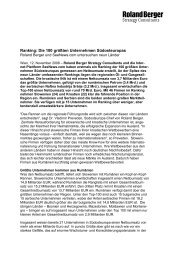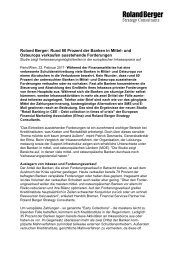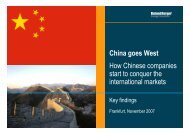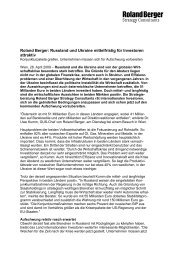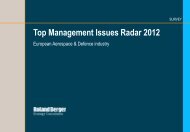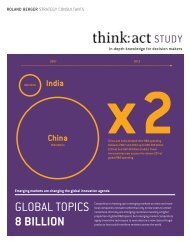Automotive Insights 01.2013 - Roland Berger
Automotive Insights 01.2013 - Roland Berger
Automotive Insights 01.2013 - Roland Berger
You also want an ePaper? Increase the reach of your titles
YUMPU automatically turns print PDFs into web optimized ePapers that Google loves.
over the coming years. While IHS projects only slight<br />
growth for production volumes in Europe (from 15.7<br />
million units in 2012 to 17.9 million in 2017, excluding<br />
CIS countries and Turkey), the respective volumes<br />
produced overseas will likely grow considerably over the<br />
same period (from 65.6 million units in 2012 to 82.6<br />
million in 2017). China is expected to account for about<br />
55% of this incremental volume. India and Brazil will be<br />
the other major growth markets.<br />
At the same time, we expect manufacturers to<br />
further enforce their local sourcing requirements.<br />
For more and more product segments, suppliers will<br />
be considered for successor business on overseas<br />
production only if they provide local manufacturing and<br />
engineering support capabilities. The benefit from the<br />
increased volume in Asia that has recently loaded the<br />
manufacturing capacities of European suppliers with<br />
volumes for export will soon come to an end.<br />
Suppliers are thus facing ever-increasing capital needs<br />
from two angles: They will have to open up new<br />
facilities or expand existing ones outside of their home<br />
regions. This will be a challenge particularly for small<br />
and mid-sized tier 2/3 suppliers that, unlike large tier<br />
1 suppliers, are not yet present in all major global regions.<br />
Aside from the principal investment in new facilities,<br />
the expansion of the manufacturing network will also<br />
increase financing requirements on an ongoing basis.<br />
This is due to inter-plant logistics potentially becoming<br />
more complex, and a higher total inventory being<br />
required to manage a larger number of facilities in the<br />
network (though not necessarily corresponding with a<br />
higher total business volume).<br />
Second, the constantly increasing technological<br />
complexity of vehicles and vehicle parts shows no signs<br />
of slowing down. Tight CO2 reduction targets, the<br />
long-term electrification of the powertrain, new driver<br />
26 <strong>Automotive</strong> <strong>Insights</strong> | <strong>01.2013</strong>



